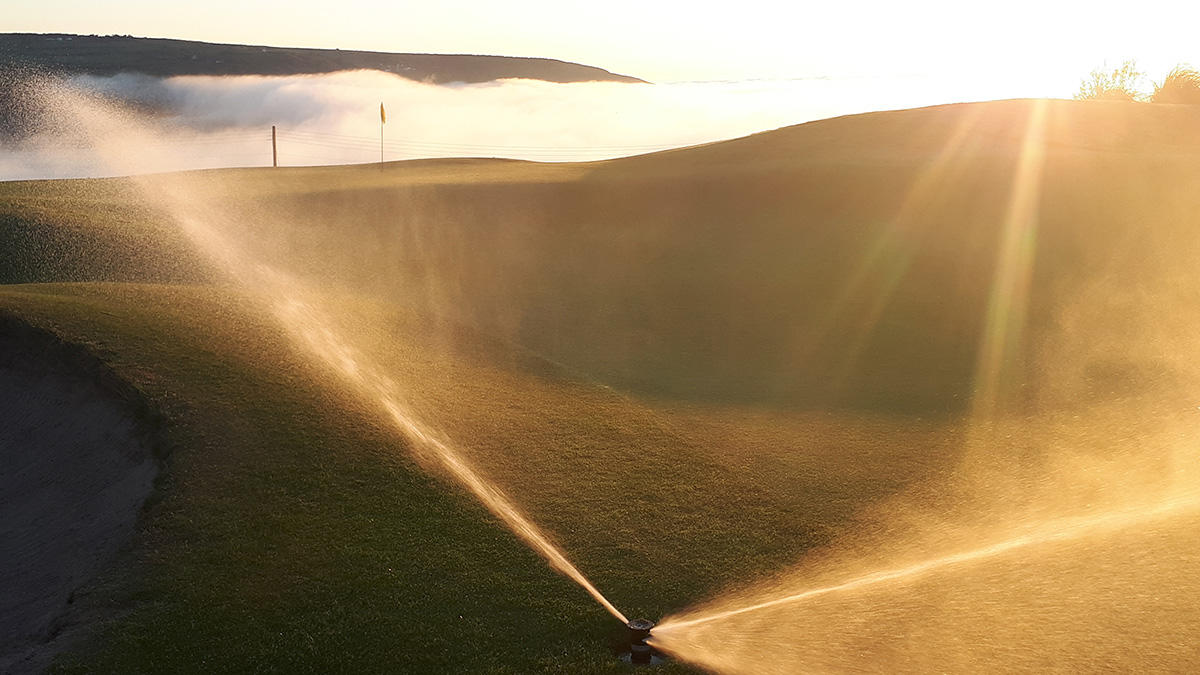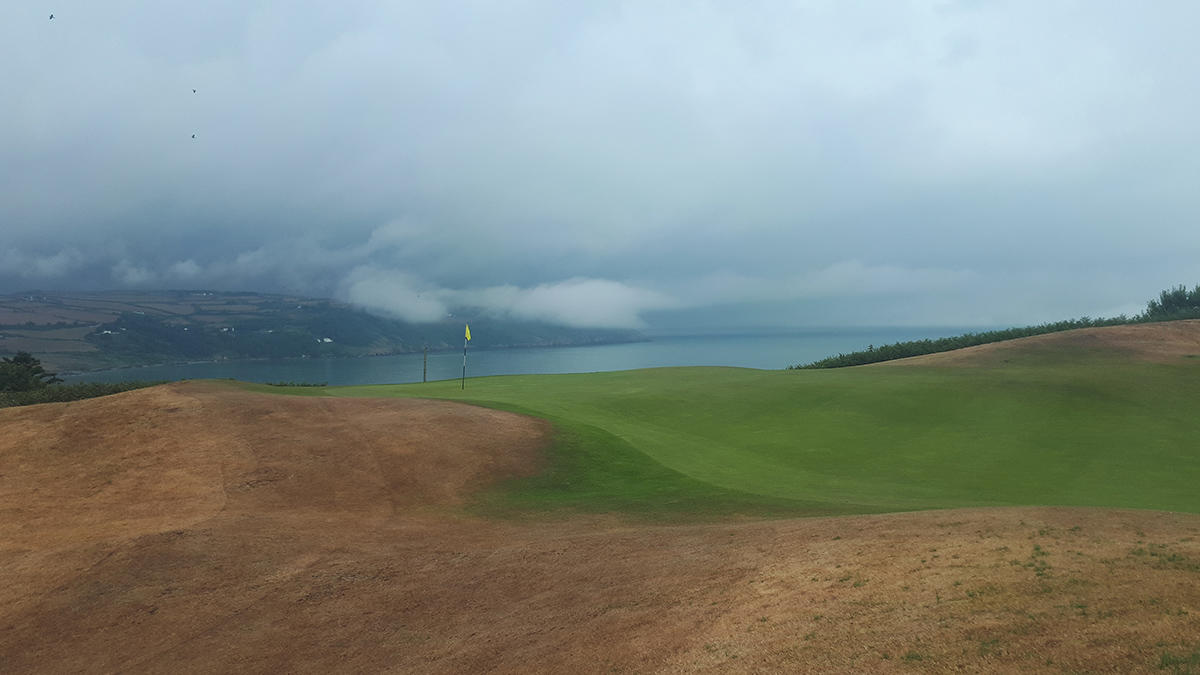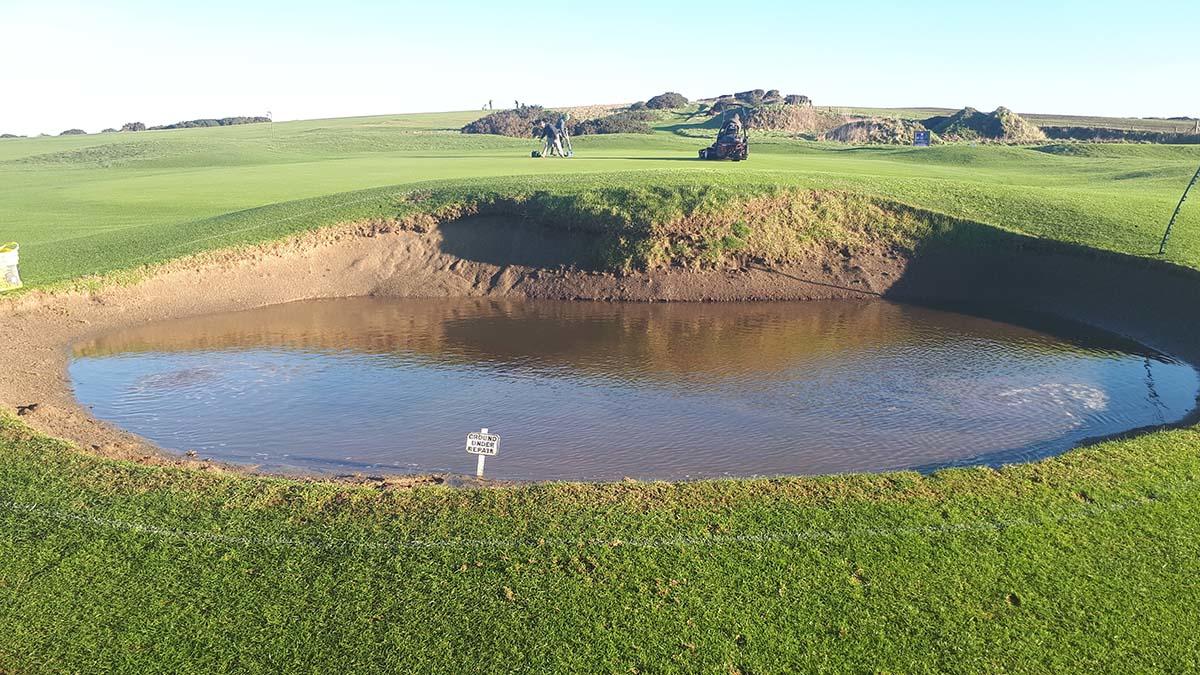- Homepage
- News and Features
- What I learned when I became a head greenkeeper
What I learned when I became a head greenkeeper

Irrigating the greens at Cardigan, with low lying cloud across the bay
It was a cold October day when I walked into the maintenance facility at Cardigan Golf Club on my first day as a head greenkeeper.
This clifftop links with a view of the sea on every hole was a dream move. I was first introduced as the “the new lad”, which was meant as a joke, but at the time I thought it couldn’t be further from the truth. I had well over 25 years’ experience in the industry and counted five golf clubs among my previous employers, including 14 years at Tenby.
The talk of a golf course with strong professional development ethics had got me excited at the interview a few months earlier. I couldn’t wait to get stuck in, but experience told me patience was always going to be key.
Years earlier, a simple post on social media had also inspired me. It said, “you can’t expect to reap the fields if you haven’t spent time sowing them”. A new addition to the team, a young Rhys Davies fresh from Elmwood College, had also encouraged me to explore the possibility of distance learning. At 39 years of age, I laid plans to return to college and re‑engage with the learning process that I had been quite content to lay to rest for many years. A BIGGA scholarship helped the financial side at the beginning and The R&A Scholarship continued to make it possible.
This process would dominate my life for the next six years and really pushed my limits of comfort and time. It would see me through countless interviews with hundreds of miles on the road, at sea and in the air. I would move employment three times but continue a normal constant family life, even once making myself unemployed, before I finally came to the doors of Cardigan.
The process enabled me to visit BTME annually, where I made fantastic friends within the industry. It would see me join the FTMI class of 2016, sponsored by Jacobsen, which I believe was the real turning point of my career, giving me the confidence to progress. Another life‑changing experience was the BIGGA Delegation to the Golf Industry Show with Bernhard and Company in 2018.
Lee Strutt MG had said to me at FTMI that we shouldn’t concentrate on the destination, rather that we should concentrate on the journey. I understand what he meant more than ever now and if I was to stop greenkeeping tomorrow, I have some incredible stories to tell.
Through all these experiences it has become clear that if you want something, you have to work incredibly hard to get it. But anything is possible and you get out what you put in, as that social media post years earlier had said.
The role of head greenkeeper at Cardigan was the step up in my career that I had been looking for ever since my friend and mentor Chris Jenkins, the head greenkeeper at Tenby, had passed away in 2014. Chris was a good friend and a role model that I aspired to emulate. He was kind, fair and more importantly, one of the team. I miss him to this day. Many people have since asked why I didn’t apply for his role in 2014, but the answer was simple and I wasn’t ready or able to do what I can now!
The early days at Cardigan
Cardigan is an average‑sized golf club with a small budget. This was my first time steering the ship, looking at budgets, staffing, meetings, products, health and safety. Where should I begin?
The answer was one step at a time, day by day, week by week.
I have always been a naturally organised sort of guy and I had been keeping a diary some years before, allowing patterns to appear in the workings of the trade. The diary has become my best friend and I hardly leave home without it.
Here are some of the thoughts that I’ve noted in my diary during my early years as a course manager:
What approach was I going to take?
What sort of image did I want to give? I hoped to be professional, yet fair and approachable. And I kept my mentor, Chris Jenkins, in the back of my mind at all times.
I spent the first three to six months monitoring the processes of the club and course, without suggesting any changes. I needed to understand the specific quirks of the location, before I made any changes. I felt academically competent, but from my experience this doesn’t always travel well from course to course.
Monitor, evaluate, then plan, became my mantra.

High above Cardigan Bay in Wales, the weather can change in an instant at the golf club
A place for paperwork?
I believe that if a club wants their head greenkeeper or course manager to manage, they should allow time for them to manage, with the time to complete the correct paperwork and communication. Time should be set aside to compare products, prices and outcomes or to network and speak to company representatives. The single biggest mistake is expecting your course manager to do these important jobs on the run or at worst, at home. Yes, a head can be hands on, but this job is so much more than being a greenkeeper. Without proper preparation or planning, a lot of courses fail. Allow your turf managers to manage.
Teamwork is critical
Delegation is also a massive hurdle that I personally struggled with. I’ve learnt to be respectful, always be clear and consistent, yet allow the greenkeeping team to breathe, grow and do what they are paid to do with pride and professionalism. Make sure you find the time to train well and do not micro‑manage.
I would always try not to ask anyone to do a job unless I was prepared to do it myself.
Most critically, be firm but fair!
Three golden rules to success
Rule one is understand what has worked in the past and don’t change it.
Only improve what can be improved for the sake of bettering the course, not furthering an ego.
Rule two is listen to the staff and members that have been at the club the longest as most will have the answers to a lot of your questions. This will mean you avoid falling into the same traps as previous head greenkeepers. Communication swings both ways.
Rule three is never be afraid to ask the obvious. Simple questions usually have simple answers.
The long way around and back to basics
At Cardigan I took conscious steps to manage the fescue (and bent to a smaller degree) within the greens and reduce the Poa. After talking to a few reps and colleagues, they all thought I was mad.
The first hurdle I faced was educating the members on how you could lift cutting heights to speed greens up. We introduced 4mm summer and 6mm winter heights, with a strong aeration programme of 8mm tines monthly through winter. When conditions allowed, we would Sorrel roll every few weeks through the summer.
I was also adamant that we would be fungicide free within a year. We would save copious amounts of money through products, but would also no longer protect the weaker grasses. March 2018 was the last fungicide application that we applied. I made the brave but fruitful decision to run with the outbreaks of fusarium and allow nature to take the weaker grasses, while promoting a healthier sward. With a little‑and‑often feeding approach and the aid of turf hardeners, more money was saved on fungicides than can be spent on seed application. It was a win‑win, although there were quite a few nervous Friday afternoons.
My nitrogen input for 2018 was just over 50kg, which further aided the thinning of the Poa annua within the green sward. This allowed nature to take its course and fescue became quite dominant.

When Stuart joined Cardigan, the bunkers were in urgent need of renovation
Manage fescue and then do not be surprised when fescue grows
Within the sward I alternate seed companies to allow eight separate fescue cultivars to grow, which furthers the hardiness of the green sward. These predominantly comprise of six slender creeping red and two chewings fescues. They are overseeded twice yearly using a Vredo. I would like to run more, but we need to be budget and time‑aware.
A six‑monthly check of profiles matched on the laptop allows me to monitor thatch levels. If the thatch stays under control, hollowtining will be put on hold.
The natural bents within the green are now adequate to allow a good mixture of species for harder wearing greens through the winter. However, the greens still need a small amount of brushing and grooming early in the season to allow the fescue to thrive and Poa seeds to be removed. I’m aware of the disturbance theory with regards to fescue but at times, good greens are about balancing the right operations with the managed species.
The big issues of the day at present are leatherjackets and worm casts, for which we have produced an integrated pest management plan for the club to work with. The plan includes switching, while repairing with brushes and rolling becomes the normal practice, not the exception. We’re always looking for cultural methods first, biological methods second and chemicals, which are increasingly being removed, as a last resort.
The final piece of the jigsaw is managing expectations. At first, Cardigan’s members and committee were unconvinced. But the increased amount of fescue and other finer grasses within the green sward has naturally sped the greens up and improved consistency, so it has really paid off.
Irrigation – don’t panic
Unpopular as this is going to sound, I’m a firm believer in managing what you have until it becomes cost effective to replace.
Better managed systems can save serious money without the need to replace.
Spotting a leak and repairing it, maintaining good angles of sprinklers and nozzles, replacing worn O‑rings. costs all add up. But if a full installation can run into the hundreds of thousands of pounds, then surely there are other cost‑effective ways of managing that system for less money. It’s the same as machinery, which you don’t replace as soon as they need new parts.
Our irrigation system is well over 30 years old and with correct management and maintenance, I see no real immediate need (even though our finances will not allow anyway) to replace the whole system yet.
We’re focusing on small sections at a time, especially if a real need becomes apparent. As a course manager you must understand budget constraints and the future financial sustainability of the club, remembering it is also a business.
Machinery – why new?
Machinery capital expenditure for a club with a small budget can make or break its financial future. Prepare well and budget, but the surest way of saving the most money is by looking after what you have.
When I talk about machinery, I always revert it back to the car your committee drove to the club in. If there is a rattle in that car and it can be fixed for a small price, most committee members would get the problem fixed. Not many would leave the issue until a breakdown occurs and costs spiral out of control. A stitch in time really does work.
Use the winter months to air out all the small issues of the machines, ready for a zero‑fault machinery count at the start of the season. Ensure machinery and units are serviced and sharp.
Make time for maintenance when machines need it – more so through the season as grass is growing and machines get used more. If not, expect breakdowns and more delays. I would suggest you spend your budget to keep on top of things, rather than saving for a rainy day with respect to maintenance or repairs.
I do wonder, why are we afraid to buy second hand machinery? Are we the only ones that look after kit properly? Do we not look at second hand cars the same way?
Second hand kit is always a risk, but for smaller budget clubs, is it that much of a risk if an expert mechanic looks at the purchase and is fully aware of the faults – if any – before purchasing?
I know this opinion isn’t going to be popular, but surely, it’s no different to purchasing a second hand car?
Millions of pounds are invested in machinery through the golfing industry, then it is poorly‑maintained or simply not used enough to warrant their initial purchase.
If you can’t afford the investment, then don’t invest. If a piece of kit starts to cost you more money than it’s worth in terms of time and money, let second hand kit be an option, instead of disregarding it completely.
Health and safety
OK, we all know the stance of most with regards to health and safety, but even on this subject can we save money by doing the right things.
Fortunately, the club had already engaged with Xact on this front and working with them to create an all‑round better approach saved hours of painstaking work in formatting and legalising actions within the workplace.
Action plans were produced on the back of risk assessments and, importantly, the plans were then followed. Xact will take on all legal responsibility, removing it from the committees or executives. This encourages more participation from our membership.
Standard Operating Procedures have been drafted for all aspects of the greenkeeping operations. These are then used as the backbone for training, which in turn increases the productivity and quality of the course.
Standardisation of all operations allows you to refer to reference sheets if you are in need of help, while any amendments are made with all those concerned made aware. This is a process that I have found invaluable.
Simple routine processes have been introduced, such as weekly housekeeping and monthly health and safety checks. This has in turn produced a more organised and clean maintenance facility, a more productive workforce and less downtime spent searching for tools or avoiding accidents.
Stuart was writing for Greenkeeper International, the monthly magazine of the British and International Golf Greenkeepers Association, which seeks to support the needs of golf greenkeepers and other groundsmen, both in the United Kingdom and overseas.
Author


